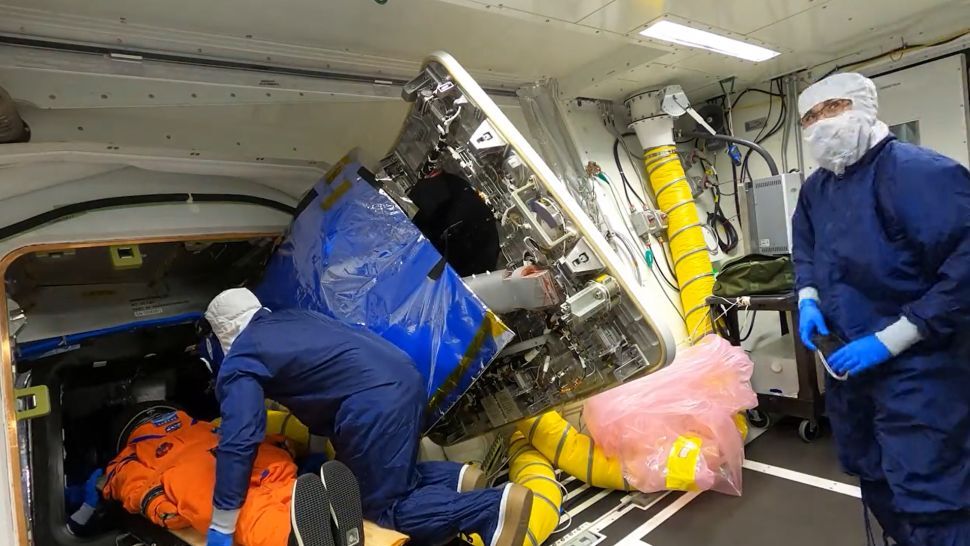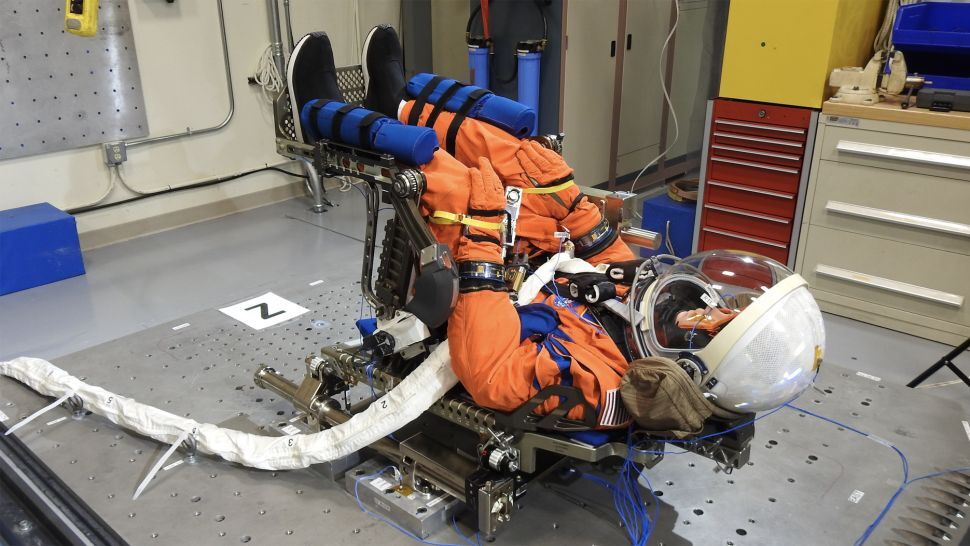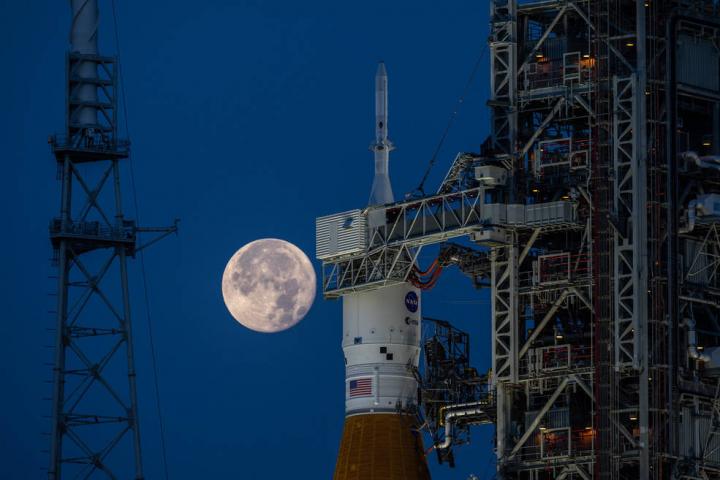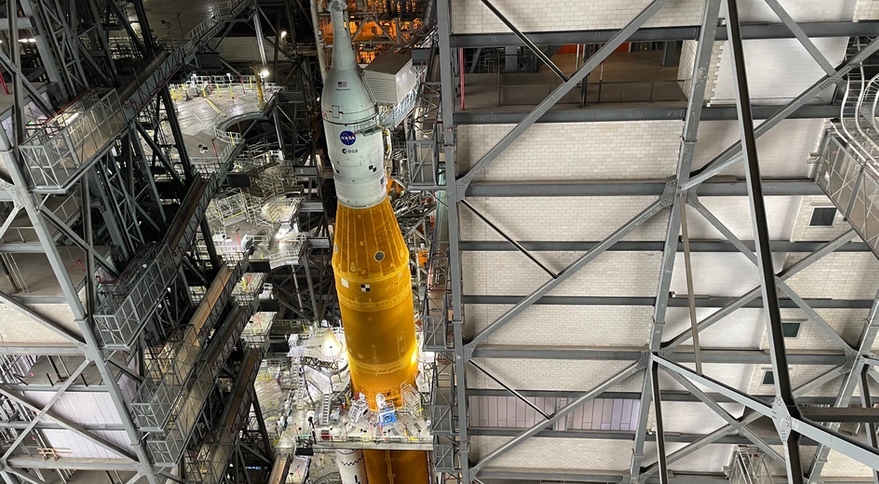1.08.2022
NASA's 'Moonikin' mannequin boards Orion spacecraft for Artemis 1 moon mission
Commander Moonikin Campos will ride Orion to the moon on NASA's new Space Launch System megarocket.

NASA technicians load the "Moonikin" mannequin in an orange spacesuit through the Orion space capsule hatch on July 27, 2022. The mannequin will measure the deep space environment around the moon during Artemis 1.(Image credit: NASA)
NASA has completed the next steps in the Artemis 1 mission — installing the data-gathering mannequin Commander Moonikin Campos inside the Orion spacecraft that will launch to the moon atop a brand-new megarocket.
In a tweet posted on July 27, NASA's Exploration Ground Systems team announced that Campos has been successfully installed into the Orion Capsule — which is atop the Space Launch System (SLS) rocket for the Artemis 1 mission around the moon. Liftoff is currently targeted for Aug. 29.
Moonkin Campos — named after Arturo Campus, an electrical engineer who was a key player in bringing the Apollo 13 mission safely back to Earth — is a human-sized test dummy that is now strapped into the commander's chair at the head of the capsule.
During the mission, Moonkin will provide NASA scientists with vital data on what future human crew members may experience during flight. Artemis 1 is NASA's first launch test of the Space Launch System megarocket and an uncrewed test flight to the moon for NASA's Artemis program. The data from Moonikin will help NASA prepare astronauts who will fly around the moon on the Artemis 2 mission in 2024 and the Artemis 3 astronauts who will eventually land on the moon.
"He will measure vibrations and accelerations that future NASA Artemis astronauts will experience," NASA's Exploration Ground Systems tweeted(opens in new tab).
These vital measurements will be collected by two sensors placed behind the commander's seat and under the headrest which will record the acceleration and vibration generated throughout the mission to the moon. Campo is also equipped with two radiation sensors to measure exposure.

NASA's Moonikin Campos will wear NASA's new Orion spacesuit during its launch to the moon on the Artemis 1 moon mission. (Image credit: NASA)
Also along with donning important sensory hardware, Campos is sporting the latest flight wear fashion — the First-Generation Orion Crew Survival System spacesuit. The same orange pressure suit that astronauts will wear during future launches and re-entries.
Campos will not be alone during the Artemis 1 mission and will be accompanied by two other mannequin "passengers" — Helga and Zohar — who will be installed aboard Orion in the coming weeks. These two limbless phantom mannequins are a part of the Matroshka AstroRad Radiation Experiment (MARE), which will record data about radiation levels during the mission to the moon.
The mannequin trio is set to ascend beyond Earth's atmosphere and head to the moon as part of the Artemis 1 mission which is targeted to launch on Aug. 29.
Quelle: SC
----
Update: 5.08.2022
.
First SLS launch remains on schedule for late August

NASA officials said Aug. 3 they are on track to roll out the first SLS to the pad Aug. 18 for an Artemis 1 launch attempt as soon as Aug. 29. Credit: NASA/Kim Shiflett
WASHINGTON — Preparations for the first flight of the Space Launch System remain on track for a liftoff as soon as Aug. 29, NASA officials said Aug. 3.
SLS managers and agency leaders said the work to prepare the SLS and the Orion spacecraft for the Artemis 1 mission inside the Vehicle Assembly Building (VAB) at the Kennedy Space Center was “on plan” to support a rollout to the pad Aug. 18 and a launch 11 days later.
“We are in the final stretch,” Charlie Blackwell-Thompson, Artemis 1 launch director at KSC, said at a briefing to preview the mission. “We are targeting that rollout date of Aug. 18. We are on plan for that at this time.” A rollout that day would allow a launch on Aug. 29.
Since NASA announced the targeted launch date July 20, crews have been working on both SLS and Orion, ranging from completing repairs to the rocket to installing payloads inside the Orion capsule. Technicians also powered on Orion for the final time before launch last weekend.
One remaining item to complete is testing of the rocket’s flight termination system (FTS) in the “intertank” portion of the core stage. That testing will begin next week, she said.
The FTS could complicate launch planning for Artemis 1. At a July 20 briefing, NASA officials said the Eastern Range requires testing 15 days prior to launch. Doing so, said Cliff Lanham, senior vehicle operations manager for the Exploration Ground Systems program, creates “some challenges” to complete close-out work on schedule.
The testing also starts a 20-day clock to conduct the launch. “We do have issues with that timing,” he said then, to support backup launch opportunities on Sept. 2 and Sept. 5. NASA was working with the range to try and resolve those concerns.
At the Aug. 3 briefing, Blackwell-Thompson said those discussions with the range are ongoing. “We have provided all the performance data to the range,” she said. “The range has that data. They’re reviewing it currently.”
Current plans, she said, would allow two launches in that 20-day period. “We’ll be continuing to review that data with the range and, should additional days become available, we will factor that into our scrub planning.”
The briefing offered few other new details about the mission, instead providing the overview of the flight. The SLS will send the uncrewed Orion spacecraft to the moon, where the Orion service module’s main thruster will fire for a “powered fly-by” of the moon, placing it in a distant retrograde orbit around the moon. Orion will later exit the orbit and return to Earth, splashing down off the coast of San Diego Oct. 10, assuming a launch Aug. 29.
The mission will test both SLS and Orion before Artemis 2, the first mission to carry astronauts, scheduled for no earlier than 2024. “We have a ‘lean forward’ strategy on Artemis 1 because it is an uncrewed test flight,” said Mike Sarafin, Artemis 1 mission manager at NASA Headquarters. That means sending Orion to the moon even if there may be issues with the spacecraft in order to bring it back, testing the mission’s primary objective of demonstrating that Orion’s heat shield can work at lunar reentry velocities.
“We will be ‘go’ for failures on Artemis 1 that we would normally be ‘no go’ for on Artemis 2, on a crewed mission, in the interest of crew safety,” he said. “We’re trying to buy down risk for crewed flights, so we’re willing to take more risk on Artemis 1, on an uncrewed test flight, than we would on later crewed flights.”
“That’s why it’s a 42-day mission,” added NASA Administrator Bill Nelson, noting additional tests planned for the spacecraft. “Just remember, it’s a test flight.”
Quelle: SN
----
Update: 10.08.2022
.
NASA’s Moon-observing CubeSat Ready for Artemis Launch

NASA’s Moon-observing CubeSat Ready for Artemis Launch
NASA’s water-scouting CubeSat is now poised to hitch a ride to lunar orbit. Not much bigger than a shoe box, Lunar IceCube’s data will have an outsized impact on lunar science.
The satellite is integrated into the Space Launch System (SLS) rocket and ready to journey to the Moon as part of the uncrewed Artemis I mission, launching this year.
Orbiting the Moon, Lunar IceCube will use a spectrometer to investigate lunar ice. Earlier missions revealed water ice on the Moon, but Lunar IceCube will further NASA’s knowledge about lunar ice dynamics.
Scientists are interested in the absorption and release of water from the regolith — the Moon’s rocky and dusty surface. With Lunar IceCube investigating this process, NASA can map these changes as they occur on the Moon.
Lunar IceCube will also study the exosphere — the very thin atmosphere-like volume surrounding the Moon. By understanding the dynamics of water and other substances on the Moon, scientists will be able to predict seasonal changes for lunar ice that could impact its use as a resource in the future.
This will all be achieved from an efficient and cost-effective CubeSat that only weighs 31 pounds. Lunar IceCube is one of several CubeSats catching a ride to the Moon aboard Artemis I. These small satellites, along with future Artemis missions, will increase our knowledge for living and working on the Moon and eventually Mars.
Lunar IceCube is funded by NASA’s Next Space Technologies for Exploration Partnerships program, or NextSTEP, in support of NASA’s Artemis Campaign Development Division within the Exploration Systems Development Mission Directorate. The Lunar IceCube mission is led by Morehead State University in Morehead, Kentucky; NASA’s Goddard Space Flight Center in Greenbelt, Maryland; NASA’s Jet Propulsion Laboratory in Southern California; NASA’s Katherine Johnson Independent Verification and Validation Facility in Fairmont, West Virginia; and Busek Space Propulsion and Systems in Natick, Massachusetts.
Banner image: Illustration of NASA's Lunar IceCube mission investigating lunar ice. Credit: Morehead State University
Quelle: NASA
----
Update: 12.08.2022
.
NASA to Stream Artemis I Rollout, Briefings on Science, Tech Payloads

NASA will hold a trio of media teleconferences the week of Aug. 14 to preview the science and technology payloads that will fly as part of the agency’s Artemis I flight test. NASA also will provide livestream coverage of Artemis I’s move to the launch pad ahead of its targeted no earlier than Monday Aug. 29 liftoff.
Artemis I is an uncrewed flight test, the first in a series of increasingly complex missions to the Moon. Through Artemis, NASA will land the first woman and the first person of color on the Moon, paving the way for a long-term lunar presence and serving as a steppingstone to send astronauts to Mars.
Ten shoebox-size secondary payloads, called CubeSats, are hitching a ride to space on Artemis I’s Space Launch System (SLS) rocket, and several other investigations are flying inside the Orion spacecraft during the flight test. Each of the payloads will perform science and technology experiments in deep space, expanding understanding of lunar science, technology developments, and deep space radiation.
Audio of all three briefings will livestream on NASA’s website. The briefings include (all times Eastern):
Monday, Aug. 15
5 p.m. – Lunar science payloads teleconference with the following participants:
- Jacob Bleacher, NASA chief exploration scientist
- Craig Hardgrove, principal investigator, LunaH-Map, Arizona State University
- Tatsuaki Hashimoto, project manager for OMOTENASHI, Japan Aerospace Exploration Agency (JAXA)
- Ryu Funase, project manager for EQUULEUS, JAXA
- Ben Malphrus, NASA principal investigator, Lunar IceCube
- Joseph Shoer, architect for Small Sat missions, Lockheed Martin
Tuesday, Aug. 16
Noon – Technology demonstration and solar system science payloads teleconference with the following participants:
- Patrick Troutman, strategy and architectures liaison for NASA’s Moon to Mars Architecture Development Office
- Dustin Gohmert, Orion crew survival systems project manager, NASA’s Johnson Space Center
- Raffaele Mugnuolo, ArgoMoon program manager, Italian Space Agency
- Rob Chambers, director of commercial civil space strategy, Lockheed Martin
- Wesley Faler, team lead, Team Miles
- Julie Castillo-Rogez, NASA principal science investigator, NEAScout, NASA/JPL/Caltech
- Les Johnson, NASA principal technology investigator, NEAScout, NASA's Marshall Space Flight Center
Wednesday, Aug. 17
Noon – Radiation secondary payloads teleconference with the following participants:
- Ramona Gaza, MARE science team lead, NASA's Johnson Space Center
- Thomas Berger, Helga and Zohar principal investigator, German Aerospace Center
- Oren Milstein, chief executive officer, StemRad
- Ye Zhang, plant biology program scientist, NASA Biological and Physical Sciences
- Sergio Santa Maria, BioSentinel lead scientist, NASA's Ames Research Center
- Mihir I. Desai, CuSP principal investigator, Southwest Research Institute (SwRI)
To participate by phone, media must send their full name, media affiliation, email address, and phone number no later than two hours prior to the start of each event to: corinne.m.edmiston@nasa.gov.
The agency is targeting Thursday, Aug. 18 to roll the Space Launch System and Orion spacecraft to NASA Kennedy Space Center’s Launch Pad 39B in Florida and will provide a live stream on the NASA Kennedy You Tube channelbeginning at 6 p.m.
Quelle: NASA
----
Update: 14.08.2022
.
NASA, Space Force resolve SLS flight termination system issue

NASA said Aug. 12 that final preparations were underway for the rollout of the SLS from the Vehicle Assembly Building to Launch Complex 39B for the Artemis 1 launch. Credit: NASA
WASHINGTON — NASA and the U.S. Space Force have resolved an issue with the flight termination system on the Space Launch System that could have cut short the vehicle’s inaugural launch campaign.
In an update late Aug. 12, NASA said it worked with Space Launch Delta 45, the Space Force unit that operates the Eastern Range, to extend the certification of the flight termination system (FTS) on the rocket from 20 to 25 days. That extension will be valid for all attempts for the upcoming Artemis 1 mission.
NASA officials previously said the 20-day limit on the FTS, after which the unit would need to be retested, restricted the launch opportunities for the mission. The Eastern Range requires the FTS to be tested 15 days before launch, starting a 20-day clock to conduct the launch. That would have allowed launches to take place on Aug. 29 and Sept. 2, but not a third opportunity Sept. 5.
“The clock starts during processing in the VAB,” or Vehicle Assembly Building, said Judd Frieling, NASA Artemis 1 ascent/entry flight director, during a briefing Aug. 5 at the Johnson Space Center. Specifically, that period starts when the batteries for the FTS are installed and charged.
Those batteries, he said, were previously certified for only 20 days. “They are in talks with the Eastern Range to extend that certification to a little bit longer than 20 days, hopefully to bring in a third attempt, but those negotiations are still in work.”
With the extension of the FTS certification to 25 days, NASA could proceed with a Sept. 5 launch opportunity if needed. That is the last launch opportunity before the current launch period, driven by operational requirements such as a daytime splashdown of the Orion spacecraft at the end of the mission, ends Sept. 6.
The FTS, designed to destroy the vehicle if it veers off course after launch, is located in an area of the core stage accessible only in the VAB and not at the pad. If Artemis 1 does not launch by Sept. 5, it would have to roll back to the VAB to recertify the FTS. Cliff Lanham, senior vehicle operations manager for NASA’s Exploration Ground Systems program, said in a July briefing that it would be a “real challenge” to complete that work and roll the vehicle back out in time for a launch during the next launch period, which opens Sept. 20 and runs through Oct. 4.
With the extension of the FTS certification, NASA is moving into the final steps of vehicle preparations inside the VAB before rolling the vehicle back to Launch Complex 39B. That rollout is scheduled to begin shortly after midnight Eastern Aug. 18.
Quelle: SN
